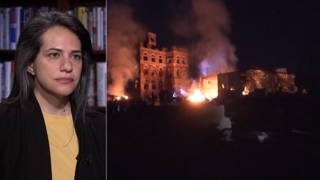
Topics
Guests
- Jeffrey Sternauthor and journalist. His latest piece for The New York Times Magazine is headlined “From Arizona to Yemen: The Journey of an American Bomb.”
In a historic vote, the U.S. Senate passed a resolution on Thursday calling for an end to U.S. military and financial support for the Saudi-led war on Yemen. This represents the first time in U.S. history the Senate has voted to withdraw military forces from an unauthorized war using the War Powers Resolution. The Saudi-led war in Yemen has created what the U.N. calls the world’s worst humanitarian crisis, with 14 million of Yemen’s 28 million people on the brink of famine. A remarkable piece in this week’s New York Times Magazine traces how bombs built by Raytheon in Tucson, Arizona, made its way into the Saudi arsenal and then were dropped on Yemeni villages. The article centers on what happened in the remote village of Arhab when U.S.-backed Saudi warplanes carried out a series of bombings on September 10, 2016. According to Human Rights Watch, at least 31 civilians were killed, three of them children; 42 people were injured. We speak to journalist Jeffrey Stern.
Transcript
AMY GOODMAN: In a historic vote, the U.S. Senate passed a resolution Thursday calling for an end to U.S. military and financial support for the Saudi-led war on Yemen. This represents the first time in U.S. history the Senate has voted to withdraw military forces from an unauthorized war using the War Powers Act. The vote, 56 to 41. But the bill is not expected to pass the House, at least this year. The vote came as peace talks in Sweden resulted in a ceasefire in the strategic port city of Hodeidah that’s scheduled to go into effect at midnight. The Saudi-led war on Yemen has created what the U.N. calls the world’s worst humanitarian crisis, with more than half of Yemen’s 28 million people on the brink of famine. A recent report by Save the Children estimates 85,000 children under the age of 5 have died from acute malnutrition brought on by the war.
We end today’s show looking at a remarkable piece in this week’s New York Times Magazine. It’s headlined “From Arizona to Yemen: The Journey of an American Bomb: When a bomb like this explodes, it doesn’t just kill people; it rearranges them.” The article traces how bombs built by Raytheon in Tucson, Arizona, made its way into the Saudi arsenal and then were dropped on Yemeni villages. The article centers on what happened in the remote village of Arhab when U.S.-backed Saudi warplanes carried out a series of bombings September 10th, 2016—two months before the 2016 election, Barack Obama still president. According to Human Rights Watch, at least 31 civilians were killed, three of them children, 42 people injured. Remnants of the U.S.-made bombs were found at the site of the attack.
We’re joined now by the journalist who wrote the piece, Jeffrey Stern. He wrote this in partnership with the Pulitzer Center; author of several books, including The Last Thousand: One School’s Promise in a Nation at War.
Jeffrey Stern, welcome to Democracy Now! Lay out what you found. Tell us where this community in Yemen is and what happened to them on that fateful day in September of 2016.
JEFFREY STERN: Hi. Well, it’s good to be with you. Yeah, so this was a district with a few villages. People had come together to build a well for themselves. This was a little bit into the blockade. It was a little bit into the food shortage. And frankly, they needed more water, and they needed their crops to grow more. It’s a very dry area. It’s a volcanic area in northern Yemen. And so people had pooled their resources to try to dig a well. And that’s pretty expensive. These are mostly subsistence farmers, so it was not easy to come up with this kind of capital, but they pulled their resources, and they built a well.
And on the day that the—actually, on the day that the well—that the drill struck water, the planes came. And first it was early in the morning, and a bomb fell and killed about six people and injured more. And then, about five or six hours later, once people had gathered to look for loved ones, to help, to just see what was going on, the planes came back, and they stayed for several hours chasing people down and dropping bombs on them.
AMY GOODMAN: And explain who they were. I mean, this is a beautifully written piece, as well. You actually, Jeff, went there. You went to Yemen, and you went to this community and met the survivors. Tell us who some of them are. Who died? Who survived?
JEFFREY STERN: Yeah, I mean, there was a man who owned a small—he was a small business owner, really. He owned a drill rig. And he was known as a pretty charitable man who would often forgive debts because often people couldn’t afford to pay for a well. And you could dig and not find anything, and it still costs tens, if not hundreds, of thousands of dollars. He was killed. There was a judge, a young judge, who had been working in traffic court, actually, who was essentially burned alive.
There were also a lot of people who survived. And one of the things that we were able to do, the magazine was able to make space for, is to describe what it’s like to try to get treatment for these incredibly traumatic injuries in an incredibly poor country that also is suffering from a blockade. So, fairly basic medical supplies are just unavailable. So, you know, even the people that survived had incredibly tough roads to recovery. And frankly, some of them will never recover. Even those who will remain alive now can’t farm. They can’t use their bodies. It’s hard to get—it’s hard to get prosthetics. It’s hard to get treatment. So, the effect of these bombs, that are designed to create massive—to create casualties in as wide an area as possible, on people who are really unable to get fairly basic medical care, it’s really devastating.
AMY GOODMAN: If you could talk about the connection of this bombing, a Saudi air attack that dropped a U.S. bomb on Yemen back two years ago, to the cholera epidemic, the worst in the world?
JEFFREY STERN: Right. Well, so—and that’s one of the reasons why we chose to focus on this strike. Now, of course, taking one water well offline doesn’t create a cholera epidemic, but the aggregate effect of hitting so much critical infrastructure, including water wells, including water treatment facilities.
The other thing that I think is really critical, that is a little bit overlooked and that I actually hadn’t even thought of until someone mentioned this when I was there, was that if you pool your resources and do something for your community, like dig a well or build a water treatment facility, and this is what happens, you kind of learn your lesson. I mean, you learn that to build a water well for yourself, to build a water sanitation treatment for your community, to build a factory, you’re inviting the planes to come. You’re inviting this kind of, you know, incredible devastation on yourself. And people were terrified and traumatized and, frankly, basically stopped doing this kind of thing, stopped building wells.
So, in the aggregate, what happened is the number of people in acute need of water spiked right around that time. About three weeks after this well was hit, the first cases of cholera were reported. And, of course, within a year, there were a million suspected cases, and it was one of the worst cases of—one of the worst outbreaks of cholera in recorded history.
AMY GOODMAN: And the U.S. military saying—give us their explanation for what they did and why they would strike a community that was trying to put in a well.
JEFFREY STERN: Well, so, the U.S. military is not doing the bombing. The U.S. military has stopped refueling. For a while they were doing aerial refueling for the Saudi military, for the Saudi-backed coalition, which is important because that allows for something called dynamic targeting, which is when the planes go up and they look for things to hit, essentially. They don’t have to necessarily depend on intelligence and plan strikes in advance. So, when you’re able to loiter, you can look for things to hit. And at the time, the U.S. was providing the refueling, which we have since stopped.
The explanation that the Saudi-backed coalition—they have something called a joint incident—a JIAT, which ostensibly investigates some of these strikes and recommends action. They eventually investigated this, came out with a very brief statement that said, in essence, that the water digger looked like it could be a ballistic missile launcher. The explanation, you know, kind of strange credulity—they just—they don’t look that much alike, a water drill and a ballistic missile launcher. There are also—if you hit a ballistic missile launcher, there would be secondary explosions. There’s fuel. And the planes came back and chased people down for several hours.
AMY GOODMAN: A double tap, as you put it, one hit after another, so people who are concerned in the community coming to save those who have been hit the first time, then they get killed.
JEFFREY STERN: Exactly, and especially children. I mean, this is a place where not a lot happens, and kids were curious. And, you know, people ran out of their houses once the sun came up, and started to gather there.
And also, you know, in this case, double tap doesn’t quite do it justice. Human Rights Watch—Priyanka Motaparthy, a researcher for Human Rights Watch, showed up within several weeks of this attack, and she found 12 craters. The people said there was—it felt like more than 20 bombs had fallen. Of course, we don’t know that. We know that at least 12 fell. So, it’s a double tap, kind of, but really it’s one explosion that drew people out and then at least 12 more.
AMY GOODMAN: And then, talk about the bomb. Talk about going to Tucson. Talk about the company that made the bomb.
JEFFREY STERN: So, that was a sort of interesting and kind of a heart-wrenching aspect of this, even after being in Yemen, is that some of the people I talked to at Raytheon really are building—they take pride in what they do. Now, this is not scientific. I did not poll thousands of workers. I talked to two, who we kept anonymous. But they are building not bombs, but the precision guidance systems that are attached to bombs. So, what they are doing, what they believe they’re doing, is taking something that would create a lot of collateral damage and allowing it to create minimal collateral damage. And theoretically—right?—that’s true. I mean, if used correctly, then, supposedly, I mean, you would use a bomb like this, and you could hit what you want to hit and avoid hitting what you don’t want to hit.
The other thing is, they talked about how much pride they take in helping the American war fighter and keeping the American war fighter safe, and actually in keeping themselves safer. Raytheon is a leader in workplace safety, I guess, somewhat ironically.
In this case, though, in the case of foreign sales, you know, we are providing these weapons sometimes to allies that are using them not as they’re designed to be used and perhaps in exactly the opposite way of how they were designed to use. So the idea of using a very precise weapon to minimize civilian casualties only works if you’re trying to minimize civilian casualties.
And, you know, I won’t go as far as saying that the Saudi-backed coalition are deliberately causing a humanitarian catastrophe. I don’t think that’s something that certainly I can know. But at the very least, they’ve been extraordinarily careless. And using these weapons to hit things like water wells, whether they believe it’s a water well or not, has created the world’s worst humanitarian catastrophe.
AMY GOODMAN: And finally, Saudi Arabia going to the State Department through Foreign Military Sales, FMS? We have just 15 seconds.
JEFFREY STERN: Yeah, I mean, we do this with a lot of different countries. The Pentagon works as sort of a broker and helps the foreign countries get what they need. And, you know, often those countries are serving our interest, or at least we believe they do. The State Department rigorously investigates, provides oversight, I should say, to these sales. But we are facilitating this. I mean, we are taking weapons from private contractors and putting them in the hands of the Saudi-backed coalition, which is bombing civilians.
AMY GOODMAN: Jeffrey Stern, I want to thank you very much for being with us. Jeffrey Stern’s latest piece for The New York Times, we will link to, “From Arizona to Yemen: The Journey of an American Bomb.” I’m Amy Goodman. Thanks so much for joining us.













Media Options